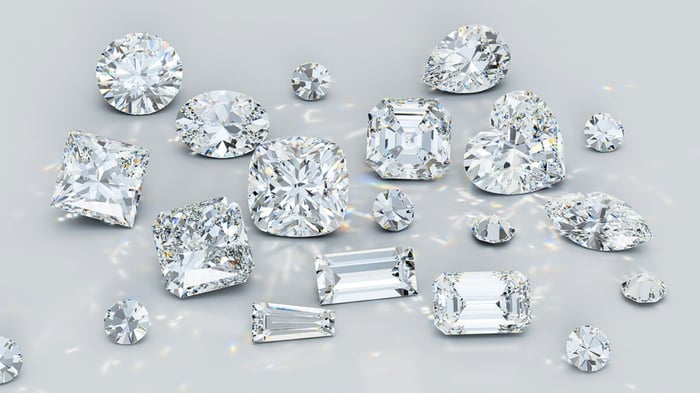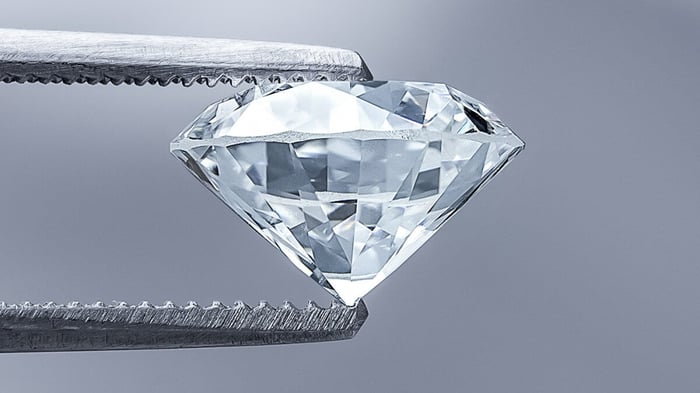Man-Made Diamonds, Are These A Girl's New Best Friend?
Diamond jewellery has value, both as an object of beauty and because of the rarity of fine diamonds. Since the late 18th century, when diamonds were found to be a form of carbon, scientists have wanted to create synthetic diamonds, imitations that look like the real thing to the naked eye.
The History Of Synthetic And Imitation Diamonds
By 1879 serious efforts were being made by James Ballantyne and a little later by Ferdinand Moissan. Moissan hit on the idea of using electricity to make diamonds after discovering small diamonds in an Arizona meteorite crater. Moissan thought he had succeeded but had created something never before seen – silicon carbide, which looks similar to diamond to the untrained eye. The new material was named after him, moissanite, for which he was given the Noble Prize for chemistry in 1906.
In the following years, there were more attempts. In 1926, Dr J. Willard Hershey working at McPherson College in Kansas used Moissan's technique and made the first synthetic diamond.
After World War 2 General Electric succeeded in devising a repeatable and reliable process to create artificial diamonds. These were tiny stones, the largest of which were 0.15mm across. Unsuited for jewellery due to their size they were ideal in industrial applications for grinding and polishing.
In 1971 GE succeeded in making gem-quality diamonds using natural diamonds as a seed around which larger diamonds were grown, up to 5mm in diameter (1 carat). These gems were yellow or brown in colour due to impurities. Shortly afterwards, colourless diamonds were created by removing the impurities, and by adding chosen impurities, blue diamonds could be made.

During the 1970s Soviet scientists also succeeded in creating a material that looked similar to diamonds using microwaves. This new material was zirconium. Initially, they thought they had created diamonds, but they had made cubic zirconium. These came to fame when Swarovski started using these crystals in their jewellery. Later becoming the darling of cheap jewellers and infomercials, by 1980, 50 million carats of these imitation diamonds were being manufactured and used in inexpensive jewellery.
In a move that might seem surprising, the De Beers company, formerly the world's largest diamond mining and marketing operation, started working on creating synthetic diamonds. By 1960, the company, through its subsidiary IDL, had succeeded in synthesising diamonds. By 1989, IDL developed a new system to grow synthetic diamonds to be used in jewellery. Rebranded, in 2002 as Element 6, on reference to carbon being the 6th element on the periodic table, IDL became one of the world's largest synthetic diamond researchers and producers.
Today, a wide range of synthetic and imitation diamonds on the market competes with the genuine, dug from the ground, formed over millions of years original article.
Imitations And Pretenders To Real Diamond
Here is a list of the significant synthetic and imitation diamonds available to jewellery buyers today.
· Rock crystals or rhinestones are crystalline quartz which, when polished, can look like a diamond. Quartz crystals are fragile and can be broken on hard impact. They are delicate and easily scratched. This material was at one time called rhinestone although these days, rhinestones are made using crystal glass or acrylic polymers.
Anillo de eternidad con 23 piedras de diamantes G/SI de 1,50 ct en oro rosado de 18 k

€2.073,95
Nuestros talentosos artesanos británicos arreglan hábilmente a mano veintitrés brillantes diamantes de calidad G/SI de origen ético de corte redondo con un peso total de diamantes de 1,50 quilates. Los diamantes están fijados en un engaste de garra alrededor de… read more
· Zircon is another mineral that can imitate a diamond. By exposing the stone to heat, zircon can turn colourless, making it look like quartz and diamond. Just like rhinestones zircon is easily scratched.

· Cubic zirconia is called the grandfather of artificial diamonds. This material is made by treating zircon. As a diamond copy, it is synonymous with low-cost jewellery and not considered suitable for high-quality jewellery.
· So-called Russian diamonds are also cubic zirconia. This variety of cubic zirconia is of very high-quality and can cost around £200 per carat. These stones are often mounted in precious metal settings that would suit real diamonds.

· Moissanite is another crystal made in a laboratory. Just like diamond, moissanite is a hard kind of stone. Although they are more affordable than diamonds, moissanite is still expensive. Moissanite tends to have a greenish shade in natural light and may sparkle more than diamond due to its light reflection characteristics. The light characteristics make it easy for experts to pick out a moissanite crystal from a genuine diamond.
· Gemisis cultured diamonds are another diamond copy. The difference between these and real diamonds is that it is impossible to make these with a clear, white colour.
· Diamond Nexus is an imitation with characteristics close to those of real diamonds. Nexus is hard enough to cut glass due to its hardness. The crystal sparkles like and is as brilliant as natural diamond. These are a relatively new entrant to the market and are much cheaper than genuine diamonds.
· Other imitation diamonds are spinel, artificial rutile and strontium titanate.
As we can see, there are plenty of imitation and synthetic diamonds on the market. It is not illegal to buy or sell them. There have been many cases of these imitations being sold as genuine, which is unlawful. Many are good enough to fool unsuspecting buyers looking for a bargain.

The best protection you can have when buying jewellery is to always ask for certification and buy from a reputable jeweller or retailer.
€4.069,95
Esta reluciente pieza de joyería seguramente será un regalo muy querido. El reluciente colgante de cruz para mujer es de oro rosado de 18 quilates y tiene 2,30 quilates de diamantes de calidad G/SI de origen ético perfectamente dispuestos para… read moreCruz de diamantes de talla redonda y talla baguette de 2,30 quilates en oro rosado de 18 k

There are good reasons why you might want to buy something other than a genuine, natural diamond. They can make a lovely and often dazzling gift at a relatively low cost. Still, both you and the recipient will always know the truth; they are not real diamonds; they do not have the millions of years of heritage and natural development. There is no monetary value to any of these products, unlike a real diamond.
At All Diamond we want you to have the full experience of owning and enjoying diamond jewellery. We have collections of all types of diamond jewellery at great prices. You don't have to settle for an imitation when you can give and own the real thing.
It may be an advertising slogan, but a diamond truly is forever. They have something special that never has to be kept secret and can be worn with pleasure and pride for a lifetime and generations to come!




